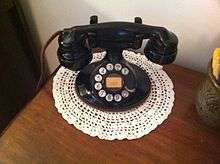Model 202 telephone

The model 202 telephone was a desktop telephone produced by Western Electric from 1930 through ca. 1937. Refurbished units appeared into the 1950s. It was a modified version of the 102-type telephone, and contained newly developed anti-sidetone circuitry to reduce electronic feedback from the transmitter (mouthpiece) to the receiver (earpiece). This sidetone created an unpleasant experience for users, hearing their own voice very loudly, and causing them to lower their own speech volume to unacceptable levels.
History
The model 202 telephone, like the 102, consisted of the desk top set, containing only the dial, the handset with integrated receiver and transmitter, a handset cradle with hookswitch, and a physically separate subscriber set (subset) which contained the ringer and the electrical components to interface the desk set with the telephone network.
The first versions of the 202 were produced by installing into existing model 102s newly developed circuitry that electrically cancels a major fraction of sidetone feedback into the receiver. The first generation of 102 and 202-type telephones featured a circular base, referred to as the B1 handset mounting. It was a redesigned shape of its predecessor the A1 which was a direct derivative of the candlestick telephone with a shortened vertical shaft. The circular base proved unstable during dialing, and therefore a new, wider, elliptical base was developed and introduced in 1930, referred to as the D1 mounting. This new D1 base remained the handset mounting paired with the E1 handset for the remainder of the 202 production run.[1]
Construction
With the introduction of anti-sidetone circuits, Western Electric began assigning assembly codes to telephones based on the electrical configuration. Until then, telephones were primarily referred to by the part numbers used to construct them. The B1 or the D1 type base without anti-sidetone circuitry became the 102-type telephone, while the same external components with a new induction coil and wiring for anti-sidetone operation became known as the 202-type telephone.[1]
The E1 handset was originally manufactured with a transmitter assembly that was surrounded by a hollow enclosure known colloquially as a spit cup, which would focus sound more effectively into the transmitter. The barrier-button transmitter element exhibited a cone shape into the spit cup and is known as a bullet transmitter among collectors. This feature was eliminated about halfway through the handset production run, when in 1934 the transmitter element was changed to a more efficient model (F1) with better voice reproduction. The F1 element had a flat disk shape and was protected by a simple plastic screen as moisture barrier and a metal grill. This element became the standard transmitter of a new handset model (F-type) in 1937, and was in use in the Bell System until the 1960s. When this new handset became available, 202-type telephones were routinely refurbished with the new handset.

The vast majority of the original production run of the 202-type telephones were produced in black finish. For an extra fee, telephones and subscriber sets could be ordered in several other colors, both flat colors or hues with metallic luster. Barbara Stanwyck talked on an ivory 202 telephone in the 1948 motion picture Sorry, Wrong Number.
Evolving models
In the 1950s large quantities of old telephones were retired in favor of the popular new model 500 telephone, creating a stock pile of still usable parts. In 1955, Western Electric reissued the 202 painted in several colors, in an effort to use up these existing parts stocks, and to satisfy the growing demand for color telephones. The new manufacturing processes to produce the new line of color sets based on the 500-type telephone were not completed yet, and those set were only issued in black until 1953. The Continental line was created from a D1 base with an F1 handset, and was available painted in primarily ivory, green, red, and black, but other colors were made available by special customer order. The Silver Continental was a D1 base, plated in silvery rhodium and coupled with an ivory painted or molded ivory plastic handset. The Imperial was sprayed with gold lacquer, and was also supplied with an ivory painted or molded ivory plastic handset.
See also
References
External links
- Western Electric Telephone Models — A look at the evolution of Western Electric's dial telephones
| ||||||||||||||||||||||||||||||